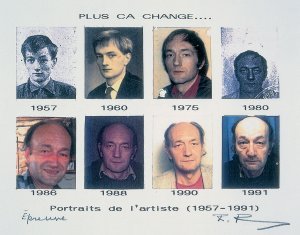1934-2002
< BACK
SELECTED CHRONOLOGY (recently updated from the England & Co exhibition catalogue published in 1989)
| 1934
|
Born on 5 June in Newcastle upon Tyne to a coal-miner who became first a missionary in Africa and then the vicar of Wakefield. Rumney was sent away to boarding school (which he did not enjoy), and later studied at Halifax School of Art.
|
| 1952-55
|
Left Halifax School of Art in frustration; worked in London and Cornwall. Registered as a conscientious objector. Went to Paris, Florence, Rome, Positano, Sicily and Venice (partly to avoid arrest for refusing conscription). Back to London with a lot of work. Sold some and returned to Sicily to work. Paris again; first contacts with Lettrists. Returned to London. Founded and edited short-lived poetry and arts weekly called Other Voices. Went to Trieste; first one-man exhibition.
|
| 1956
|
One-man exhibition at Galleria Apollinaire, Milan. Met Lucio Fontana, Yves Klein, Asger Jorn and Enrico Baj. Contacts with Movimento Nucleare and Il Movimento Internazionale per una Bauhaus Imaginista. One-man show at New Vision Centre, London. Four paintings in an international exhibition in Tokyo.
|
| 1957
|
Show with Jorn at Galerie Taptöe, Brussels. One-man show at Galleria Apollinaire, Milan. Metavisual, Tachiste, Abstract show, Redfern Gallery, London. New Trends in British Art, Rome-New York Art Foundation, Rome.
Founder-member - along with Guy Debord, Michèle Bernstein, Walter Olmo and Asger Jorn - of Internationale Situationniste in Cosio d'Arroscia, Italy. |
| 1958
|
British Abstract Painting, Auckland City Art Gallery, New Zealand. Now living between Paris and Venice and selling from the studio. Showed occasionally over the next few years in mixed exhibitions at Galerie Iris Clert in Paris and in various private and public galleries in France, Italy and Germany. Met Duchamp, Tzara, Ernst, Brauner, Bataille, Matta, Rives etc.
|
| 1959
|
Paris Biennale. Place exhibition at ICA, London. Place originated as a proposal called Hiss-Chamber that Rumney had been discussing with Alloway for at least two years. The intent was to study the way in which the artistic stimuli affected the behaviour of people in a controlled maze-like environment. Technical and financial obstacles led to its abandonment, along with a project in 1958 to study the effect of changing the colour of Venetian Lagoon on the behaviour of the visitors to the 1958 Biennale. Place itself was a collaboration between Rumney, Denny and Dick Smith; it was a sort of maze made of pictures with only four colours employed, but there was no provision for analysing the behaviour of the spectators.
|
| 1960
|
Situation, RBA Galleries, London. One-man show Galleria Pater, Milan.
|
| 1961-67
|
One-man show; Galleria II Traghetto, Venice.
By now, Rumney, like many of his contemporaries, was becoming disillusioned with the art market which seemed increasingly geared to repetitive painting and punishing artist for innovation or curiosity. Conceptual art was not an option, except in its purest sense. He became increasingly involved in a project to create an institute to foster the interplay of artists with the frontiers of science and technology. This project was well-advanced and fund-raising was about to be put in hand when in 1967 his wife Pegeen, daughter of Peggy Guggenheim, died. He no longer felt that he had to produce artefacts in order to justify describing himself as an artist. |
| 1967-83
|
Worked briefly for BPC's History of the 20th Century, writing on science and art. From '67-'75 worked for French Broadcasting. Produced regular fortnightly programmes for the English language service (an arts magazine, a science magazine and a weekly humourous programme). Also did about three 2 ½ hour 'blockbusters' a year for the French 'Third Programme' on the arts, science or their interface. In 1975, he returned to England and taught 20th-century art history and theory and film-making at Canterbury College of Art. In 1975, produced Iris Time and Life (a bilingual aural history, on cassette, of the Galerie Iris Clert). In 1979 returned to Paris and thence to Sicily.
|
| 1983
|
Venice. Made a series of affiches déchirées as a tribute to Françcois Dufrêne who had just died. Acquired a Polaroid camera and began a series of sculptures and photographs of nudes.
|
| 1985
|
One-man show, Transmission Gallery, Glasgow.
|
| 1987
|
Working in London.
|
| 1989
|
Ralph Rumney: Constats (1950-1988), solo exhibition at England & Co, London.
Exhibition catalogue with essay by Toni del Renzio published by England & Co. Tate Gallery acquires painting The Change (1957) and the British Museum acquires an engraving with mezzotint Untitled (1956). |
| 1993
|
Ralph Rumney: Works from 1953-1993, solo exhibition at England & Co, London.
The Sixties, Barbican Art Gallery, London. The 1960s, England & Co and Pentagram Galleries, London. |
| 1995
|
Ralph Rumney & Jean-Pierre Eyraud: Marie d'Outrance, Hôtel de Ville, Manosque, France.
|
| 1996
|
Two-way Traffic, British & Italian Art 1880-1980, Royal Albert Memorial Museum, Exeter.
|
| 1999
|
Autobiographical memoir of Ralph Rumney, Le Consul, published by Gérard Berreby, Paris.
|
| 2000
|
Le Comité Psycholéographique de Londres, reunion exhibition of the four founding artists of the Situationist International, Place Pagnol, Manosque, France.
|
| 2001
|
Publication of The Map Is Not the Territory by Alan Woods and Ralph Rumney. |
| 2002
|
Died, on 6 March at his home in Manosque, Provence.
|
| 2010
|
Talking of Yves: Friendships and connections in Paris, New York & London, England & Co, London.
|
Some copies of the catalogue of the 1989 exhibition Ralph Rumney: Constats (1950-1988) at England & Co are still available - contact the Gallery for details.

Ralph Rumney: The 'mes' of Yesteryear (1994).
